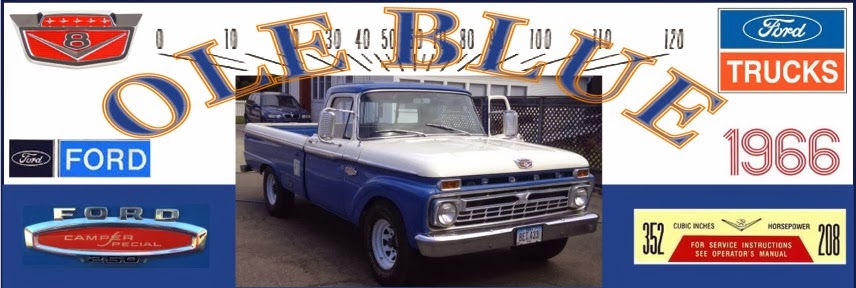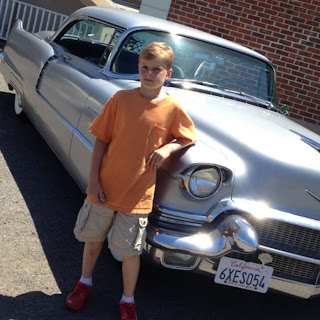Uncle Ken did not like the mechanical distributor and when I asked about the Mallory setup we see in the picture below on Jul 31, 2013, he wrote:
I think it was about three years ago that I added the Mallory ignition. I always hated points as they rusted closed all the time and then were a pain to gap properly. Cracks in distributor caps used to drive me crazy as well. Got to the point if I replaced points, I replaced cap at same time. Went to a U-wrench yard here (Des Moines) and bought the Mallory out or a wrecked Mustang. Don't recall the year of the car.
Jack and I were talking about how these engines work and the basic fuel, air, fire requirement quickly came up. We talked about the FIRE part of the "Combustion" equation first and our discussion was simple - he had played with 'snap circuits' in his younger years so we had a mental image of how from the Battery comes the charge and when the ignition key is turned a circuit is created between the battery and the spark plugs but what is all this stuff in between?
The Coil:
The ignition coil is basically a Tesla coil that supplies the ignition spark to the spark plugs, increasing the voltage from the 12V in Old Blue's battery (or alternator - later!) to 55,000V to ignite the fuel in the cylinders. Since Uncle Ken had replaced the original coil we went looking for information on what was under the hood on the web ...

The Promaster Classic series ignition coils from Mallory are designed to meet today's specialized ignition requirements. These coils feature a faster rise time and increased spark duration (compared to stock) to increase performance. They have a glass-filled polyester case and oil-filled construction to ensure a long life and no energy loss from arcing. This series also offers better wire retention with a spark plug type secondary post, and brass contact terminals [Marketing Blurb from http://mallory-ignition.com/promaster-coil-street-strip-2341.html]
Specifications of the coil include:
Coil Wire Attachment:
|
Male/HEI
|
Coil Style:
|
Canister
|
Primary Resistance:
|
0.600 ohms
|
Coil Internal Construction:
|
Oil-filled
|
Coil Color:
|
Black
|
Maximum Voltage:
|
55,000 V
|
Turns Ratio:
|
105:1
|
Secondary Resistance:
|
12.3K ohms
|
Inductance:
|
7.3 mH
|
Peak Current:
|
100 mA
|
Spark Duration:
|
500 uS
|
Mounting Bracket Included:
|
Yes
|
Coil Wire Included:
|
No
|
Ballast Resistor Included:
|
Yes
|
Coil Shape:
|
Square
|
Height (in):
|
5.297 in.
|
Length (in):
|
3.706 in.
|
Width (in):
|
3.846 in.
|
We also found the wiring diagram for installing the coil with the resistor which is the white rectanglular box in the bottom right of the picture above.
 |
| Wiring Diagram Mallory Promaster |
The Distributor:
The distributor handles several jobs. Its first job is to distribute the high voltage from the coil to the correct cylinder. We found an excellent explanation of what Old Blues Mallory distributor does to make the car run at http://www.howstuffworks.com/ignition-system4.htm.
When Uncle Ken replaced the original mechanical style distributor (including the points and condenser, etc.) with a Mallory Unilite Breakerless Distributor P/N 9155301 it seems he found an interesting replacement for the stock ignition systems for Old Blue. I looked around the web and found many great things said about these units including that these are used for racing machines NOT street autos in California becuase of emissions concerns ... Hmmmm
I kept reading and found some very interesting details on this distributor; one of the best descriptions of the Mallory Dual-Point Distributors and of interest to me because I also own an MG was a post by Ben Travato of Santa Barbara, CA on the Moss Motors site http://www.mossmotors.com/forum/forums/thread/5689.aspx
"In this article we will examine yet another alternative ignition system for your British sports car, the Mallory Dual-Point Distributor. What makes the Mallory unique among point type ignitions, is, as the name implies, it has two separate sets of points to do the work of one. What are the advantages to using two sets of points? In the Mallory distributor, one set of points opens the primary circuit and the other closes it, giving a longer period of dwell (the period of time that the points are closed, expressed in degrees).
The dwell period is the time when the secondary windings in the ignition coil charge the magnetic field up for another high voltage blast when the points open (20,000-40,000 volts!). It can generally be said that the longer the period of dwell, the higher voltage the spark. On most four cylinder engines, the dwell period is about 60°, but the Mallory Dual-Point Distributor has a dwell period of 72°, so even if you choose to use your stock coil, you will still have a "hotter" spark, as the coil has more time to charge itself up than with a conventional distributor. This is accomplished in the Mallory unit by the following process. In the four cylinder distributor the point cam has eight lobes, and as it rotates, it opens the primary set of points completely, triggering the coil. Then the lobe rotates another 8° and opens the secondary set of points. Shortly after the secondary set has begun to open, the primary set closes, and the ignition coil starts charging even though the secondary set is still open. After the secondary set has closed the process starts again for the next cylinder.
Why not just crank open the points for more dwell in your stock distributor? You could, but this would have an adverse effect on the ignition timing and the points would wear in short order, as they are designed to work at a specified gap, all of which would result in a loss of performance and economy. Another feature of the Mallory Dual-Point Distributor is the fact that it has a full centrifugal advance unit, rather than the part-centrifugal, part-vacuum advance system used on the stock Lucas distributors. This feature may make it illegal for use on pollution-controlled vehicles (check your local and state laws before using this unit on the street) but makes it perfect for use with high performance engines equipped with sidedraft carburetors that often lack a vacuum port for use with a stock distributor. The Mallory unit is also easily adjustable for total amount of ignition advance, and comes preset at 28° allowing the serious enthusiast the ultimate in tune-ability. The Mallory Dual-Point is supplied without a drive dog or gear, which must be transferred from the old distributor. Mallory has been making high performance ignition systems since 1932, was even a popular modification to MG TCs when they were new!
Today there is a Mallory Dual-Point to fit most British cars, so if you're looking for the ultimate in high performance ignition systems, look no further than the Mallory Dual-Point distributor " .
Wow - it takes a lot of engineering to apply a charge to a spark plug. It took a couple of days for all this to sink in and I'm thinking we will see a bit of complexity with this definite non-stock component!!
 |
| Wiring Diagram Mallory Comp9000 |














